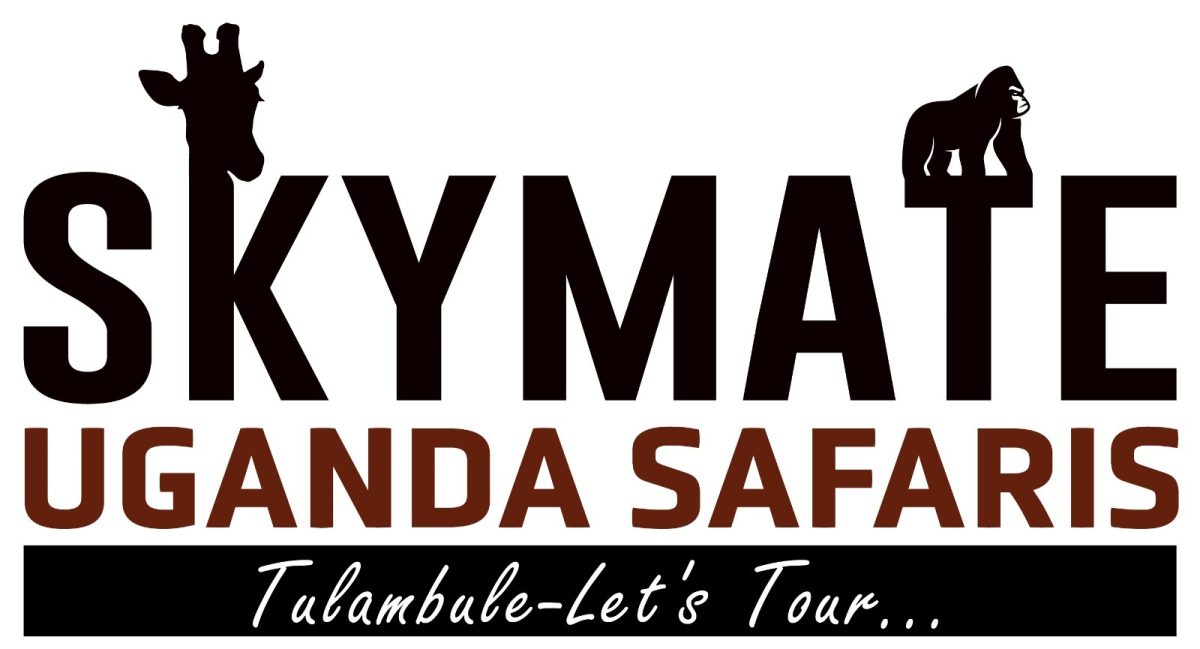Table of Contents
ToggleLooking for ideas for things to do in Kampala or best places to visit? You have come to the right place!
In this post, you will find a great selection of the best things to do and exciting outdoor activities in Kampala that you probably didn’t even know about.
Kampala is the capital city of Uganda.
It is also the business, finance, and cultural hub of the country.
The city is located in Central region of the country, about 40km from Entebbe Airport. It covers an area of about 189km2 and has a population of about 1.6 million.
Most visitors on Uganda safaris are often driven up country, away from this bustling capital. We think there are 3 main reasons that people don’t tour Kampala.
One is lack of time – many plan a packed safari itinerary focused on wildlife viewing with no time set aside to explore Kampala.
The second is most visitors live in towns; you can understand they don’t find an idea of a busy city appealing. The third is fears related to safety and crime. Kampala isn’t the safest city in the world, but you can safely explore the city if you take precautions.
A list of The Best Places To Visit In Kampala
- Uganda National Museum – the oldest museum in East Africa
- Uganda Martyrs Shrine Namugongo; where several converted Christian pages/helpers in the Kings’s Palace were burnt alive.
- Kasubi Royal Tombs – a UNESCO World Heritage Site
- Kabaka’s Palace & Idi Amin’s Torture Chamber
- Bulange Mengo, which houses the Lukiiko (Parliament) of Buganda Kingdom.
- Buganda Royal Mile – a stretch of rich history and cultural heritage
- Kabaka’s Lake – a man-made lake dug on the orders of the King of Buganda
- Ndere Cultural Center for traditional dance performances
- Bahai Temple – a place of worship of the Baháʼí Faith.
- Gadhafi Mosque – Uganda National Mosque
- Luabaga Cathedral – a cornerstone of the Catholic Church history in Uganda
- Namirembe Cathedral – Uganda’s oldest cathedral
- Nakasero Market – a commercial hub that provides insight into local life in Kampala.
- Art Galleries and Buganda Road Craft Village – for souvenir shopping
- Independence Monument and Uganda Parliament building
- Makerere University – Uganda’s largest and oldest institution of higher learning, first established as a technical school in 1922.
- Shopping Malls, Coffee shops and Local Restaurants
- Taxi parks and Owino Market
Best Things To Do On A Kampala city Tour

1. Guided Kampala City Walking Tour
The best way to explore the heart of Kampala City is by taking walking tour through the Central Business District.
The tour offers a wonderful opportunity to get a glimpse of urban African life as locals live it. You will experience the hustle and bustle of the city, take in the sights and sounds of the vibrant streets and mix with the locals.
2. Climb gaddafi mosque Minaret
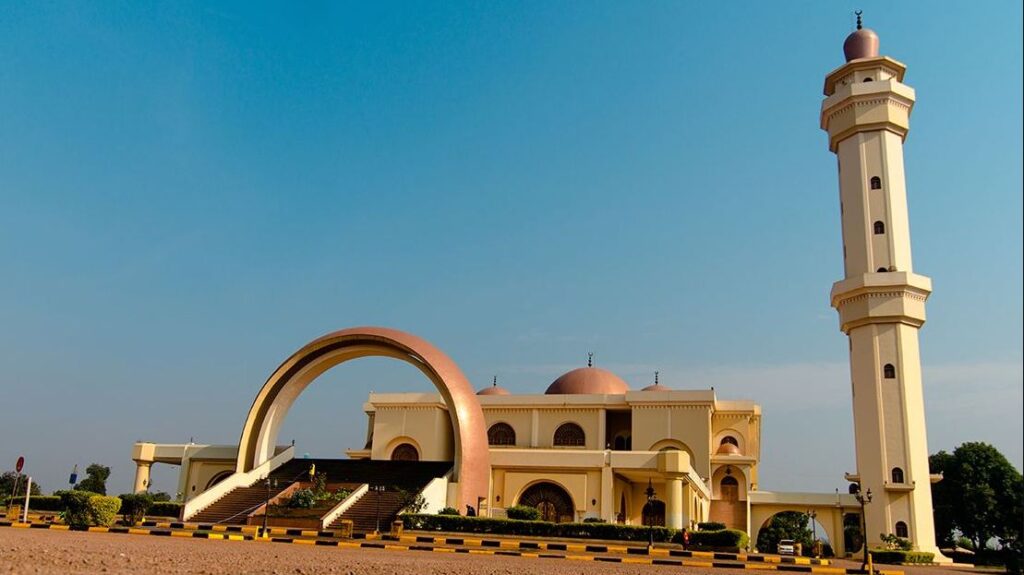
A gift from the late Colonel Muammar Gaddafi of Libya, the Gaddafi Mosque is a treat for both Muslims and non-Muslims.
Also called Uganda National Mosque, this impressive, copper-domed building is one of the largest mosques in Africa.
It is found on old Kampala hill close to the central business district and can accommodate about 12,000 worshippers.
Its huge prayer hall is decorated with stained glass from Italy, an enormous blue and red woven carpet, and intricate chandeliers from Egypt.
It’s mainly visited for its 60m high minaret. Climbing the 306 steps to the top of the minaret rewards you with a stunning 360° view of Kampala city – the perfect way want to capture an aerial shot of Kampala city without flying a drone.
3. Take A “Kampala Boda Boda” Tour
Popularly called “boda boda” in Uganda, the motorcycle taxis are the quickest way to explore Kampala.
You drive through busy city visiting the popular attractions and landmarks, access nice viewpoints, go to the suburbs and ghettos, visit historical sites, green spaces, eat in local places and taste the African cuisine, etc.
These motorcycle taxis are not for the faint-hearted, but can take you anywhere in the city without being hindered by the crazy Kampala traffic jam.
4. visit Uganda National Museum at Kitante

Uganda Museum is located within the Kampala central division along Kitante road near the British High Commission.
The museum was set up in 1908 by the then British Colonial Officer George Wilson, when Uganda was still under colonial rule.
It is the oldest museums in the whole of East Africa, featuring an impressive collection of artifacts, exhibits on traditional crafts, and displays of Uganda’s diverse cultural heritage.
Learn about Uganda’s pre-colonial, colonial, and post-colonial history, as well as the country’s ethnic groups, traditions, and customs.
5. Tour The Bahai Temple on Kikaya hill

A visit to the beautiful Bahai temple offers a spiritual experience of some sort. Constructed in 1958, the temple sits on a beautiful spot on top of Kikaya hill, 7km on the Gayaza road.
There is only one temple of the Bahai faith on each continent and Uganda is lucky to have the one for Africa. The temple has stunning architectural design.
Like all Baha’i temples, it’s a circular 9-sided dome.
Inside, fixed mosaic tiles from Italy line the dome’s arched roof, with coloured glass in the wall panels that came from Germany.
The green, amber and pale blue glass tinted windows filter the light coming into the temple, lending itself to an effect of lightness that bounces off the floor, well adorned with Persian carpets.
Bahai Temple is set in the middle of lush, green gardens with fields of brightly coloured flowers where many birds and butterflies flutter.
The temple welcomes visitors of all faiths to pray and meditate in a serene environment.
The entry is free!
6. Tour Kasubi Tombs Of Buganda Kings
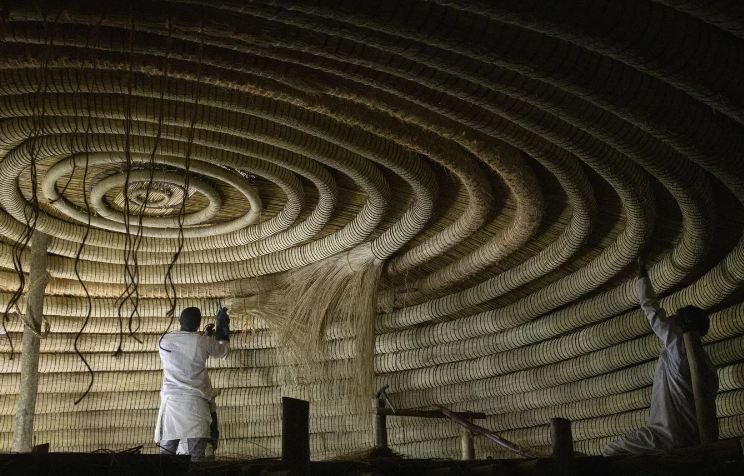
Until the end of the 19th century, Uganda was divided into 5 kingdoms.
Kampala was the capital of the largest, Buganda, from which the country takes its name.
Sadly not much remains from that time, but you can still visit the Kasubi Tombs, where four of the kings of Buganda, known as kabakas, are buried.
This UNESCO World Heritage Site is situated 5 km away from the city centre on Kasubi Hill.
And taking a tour here offers you the opportunity to get fascinating insights about culture and traditions of the Baganda people.
7. Attend Traditional Dance Performances At Ndere Cultural Centre

Meaning “flute” in local Luganda language, Ndere is the biggest and the oldest traditional dancing troupe in Uganda.
Founded in 1986, it is one stop center to see Uganda’s diverse cultures showcased through the different traditional dances and songs.
The shows takes place in the evenings, which makes it a perfect place to end your day after a Kampala city tour.
8. Explore Buganda Royal Tourism Circuit
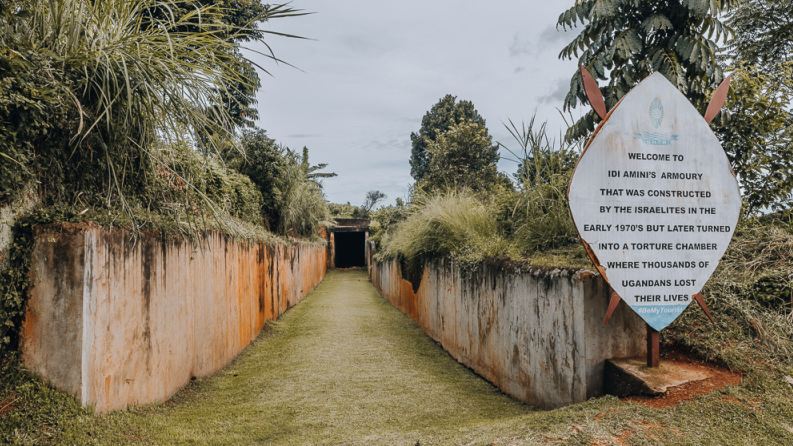
The Buganda Royal Tourism Circuit includes Kabaka’s palace and Idi Amin’s Torture Chambers; Bulange Royal Building which houses Buganda parliament (“lukiiko”), and the Royal Mile, which is a path one mile long, connecting the palace to the parliament.
Taking a tour of these cultural landmarks is an educating experience on the pre-colonial, colonial, and post-colonial history of Buganda and Uganda, giving you a lesson about the rich cultures of the black people.
It is a revelation into the spectacular administration systems of a people that are absurdly portrayed to have lived a primitive wild life before the white man arrived.
As an extra to the tour, you can visit the nearby manmade Kabaka’s lake that was created by the young flamboyant king, Kabaka Mwanga, with the intention of connecting to Lake Victoria so he could easily access Lake Victoria and one of his palaces at Munyonyo.
9. Market Shoppings
Popular Kampala markets include Nakasero food market and the maze-like Owino which was once Kampala’s best place for second-hand clothing, shoes and bags.
If you are into arts and crafts and souvenir shopping, there are many craft markets in the city.
If you want typical African crafts, visit the Exposure Africa market on Buganda Road.
Here you’ll find a wide selection of handicrafts including wood carvings, leather and jewellery.
If you are a lover of art, Kampala also has great art galleries for you to quench your thirst.
A number of art galleries are located within the city center and therefore easy to access. One such gallery is the Nomo Gallery.
10. Visit Uganda Martyrs Shrine
The Uganda martyrs shrine tour is one of the most spiritually nourishing experiences for a Christian pilgrim.
It is also a great source of history about religion in Uganda.
The tour takes you to the site where several converted Christian pages/helpers in the Kings’s Palace were burnt alive.
The pages had disobeyed the orders Buganda king that were contradictory to their faiths and accepted to die for their beliefs when the king ordered for their killing.
11. Tour Saint Paul Cathedral
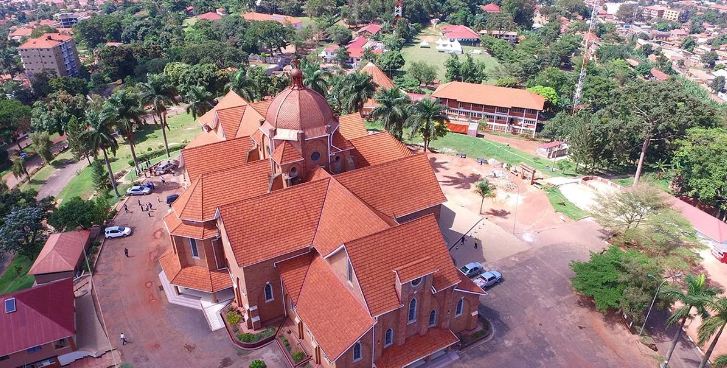
St Paul’s cathedral is the oldest Anglican Church in Uganda.
The vast red-brick building is over 100 years old. It is situated on the top of Namirembe hill that offers more stunning views of Kampala city.
In 1875, Henry Stanley, the British explorer visited Kabaka Mutesa I’s palace and told him about Christianity. Mutesa I, enthralled by the stories that he heard, asked Stanley to write to Queen Victoria of England and ask her to send missionaries to Buganda.
Two years later, 8 missionaries from the Church Missionary Society arrived in Buganda and began to preach Christianity and make conversions.
When Mutesa I was succeeded by his son Mwanga II in 1884, Christianity came under attack when Mwanga, angry that the Christian converts placed their God above traditional loyalty to him as Kabaka, resolved to wipe out the new religion.
Bishop, James Hannington, the first Anglican Bishop of the Eastern Equatorial province was the first victim, killed in 1885 on orders from Mwanga, and in 1886, he put to death 26 of his pages that refused to renounce Christianity.
It was after Mwanga was deposed and exiled in 1899 that development of Namirembe as the main Anglican place of worship began.
12. Visit Saint Mary’s Cathedral At Rubaga Hill

Saint Mary’s Cathedral, the seat of the Cardinal of the Roman Catholic Church in Uganda, also has a long cultural and political history dating back to the heyday of the Buganda Kingdom.
In the early 18th century, Lubaga Hill was the administrative heart of the Buganda kingdom. Many of Buganda’s military expeditions, including later ones against the colonialists were planned from Lubaga because of its strategic view.
The hill derives its name from the Luganda word ‘okubaga’, which means ‘to plan’.
In 1891, King Mwanga who would later slaughter catholic converts donated Rubaga hill to Catholic missionaries through Bishop Joseph Hirth.
Between 1891 and 1914, seven different rudimentary churches were built on the hill.
The first was burnt down in 1892 during religious wars to be replaced by another, until 1914 when there was need for a more concrete church to cater for the big catholic population around Rubaga.
Construction of the cathedral took 10 years and on 31st Dec 1925, it was consecrated.
13. Dive Into Kampala Night Life
Take a walk around Kampala on any given afternoon, and you would be forgiven for guessing the nightlife is pretty quiet.
The laid-back nature of the people might lead you to believe that they all head to bed early, after a cup of coffee and some prime-time TV.
The reality couldn’t be more different. In fact, the nightlife here has made Kampala somewhat notorious as the party city of the region; something the Kenyans, Tanzanians, and Rwandans you’ll meet in town will certainly testify to.
14. Taste Local Foods

If music and dancing is not really your thing, Kampala city is also known for is organic delicious food.
You will find lots of restaurants and eateries serving a wide range of healthy dishes. There are also amazing coffee places such as Endiro Coffee and 1000 Cups of Coffee.
While in many countries, the word Rolex is usually synonymous with luxury watches, here a “rolex” is a popular street food.
As Ugandans have been known to say: “We don’t wear Rolex, we eat them.” Rolex – the snack – is a shortening of “rolled eggs”.
The popular dish, found at roadside stalls almost everywhere in the city, is made from a vegetable omelette with added tomatoes wrapped up in a chapati.
It has already achieved some notoriety beyond Uganda and in 2022 the Guinness World Records certified the world’s largest rolex.
15. People-watching at Old and New Taxi Parks

The Old and New Taxi Parks are bustling transportation hubs that can be interesting places to visit and se in Kampala. It is here that taxis (matatus) converge.
Passing by the taxi park, away from the more touristy areas, offers you a chance to witness the vibrant hustle and bustle of Kampala’s transport chaotic public transport firsthand, and it’s a fantastic spot for people-watching.
FAQs About Kampala City
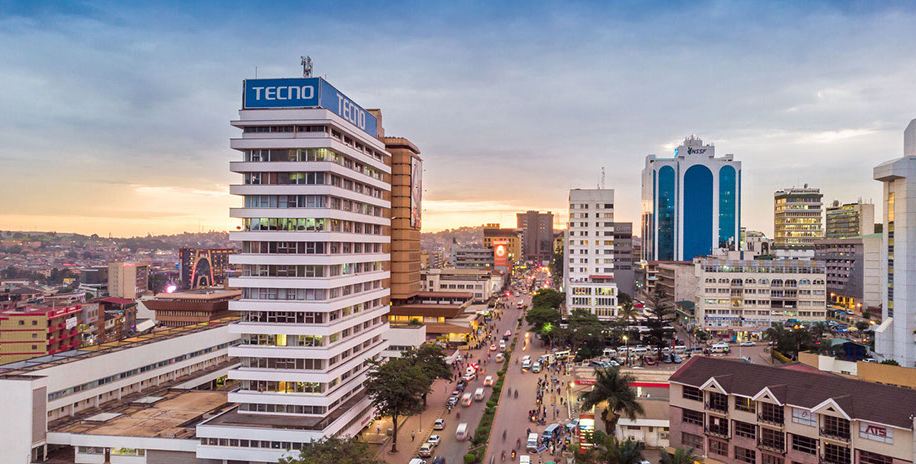
1. What Does Kampala Mean?
Kampala originally referred to only the present-day Old Kampala hill.
This is where Fort Lugard was located and the initial headquarters of the British colonial authorities in the soon to be Uganda Protectorate.
Before the British construction of Fort Lugard, the hill was a hunting reserve of the King (Kabaka) of Buganda. It had many antelope species especially the impalas.
When the British colonial officials were allocated this hill by the then Buganda King, they referred to it as “The Hill of the Impala”.
The Baganda people, in whose territory this British settlement was found, then translated “Hill of the Impala” as Akasozi ke’Empala.
This was then shortened to K’empala and finally Kampala. Kasozi means “hill”, ke “of”, and empala the plural of “impala”.
2. Is Kampala Worth A Visit?
The busy city of Kampala makes a good introduction to Uganda. It is a dynamic and engaging city, with several worthy attractions to keep you occupied for a couple of days.
It is also a city where you can really learn about Uganda, whether you are interested in colonial history, Ugandan independence, or modern life in Uganda’s capital city.
From the ritzy suburbs to the busy Central Business District to large slum areas, Kampala is a multi-faceted city worth exploring.
If you are interested in history, African art, culture, music, food, crafts, or shopping, you are sure to find something of interest to do and see in Kampala city.
3. How Do You Spend A Day In Kampala?
If you only have 1 day to see Kampala, I highly recommend booking a 1-day Kampala City Tour with a guide that can tell you everything about this capital city of Uganda and its history.
On this tour, you will visit most well-known monuments and top tourist attractions in Kampala.
Along the way you can taste Kampala’s streetfood on the colorful markets and submerge yourself in Uganda’s vibrant culture.
4. What Is The Price For A City Tour In Kampala?
Prices for the Kampala city tour vary from around US$30 to US$100 depending on the hours of exploring (half-day or full-day) and your preferred mode of transportation.
You can choose a motorized city tour or a simple walking tour in Kampala.
A combination of these options is advisable to cover more of all the top sights Kampala has to offer.
We can customize the tour to your personal wishes and advise about what to do in Kampala or organize your safari.
5. Where To Stay in Kampala?

Kampala offers a variety of accommodation choices.
Accommodation in Kampala ranges from luxury city hotels to relaxed suburban resorts and guest houses – enough to suit all tastes, budgets and trip types.
These include:
- Kampala Serena Hotel
- Kampala Sheraton Hotel
- Latitude 0° Hotel
- Lake Victoria Serena Resort & Spa
- Speke Resort Munyonyo
- Protea Hotel By Marriott Kampala
